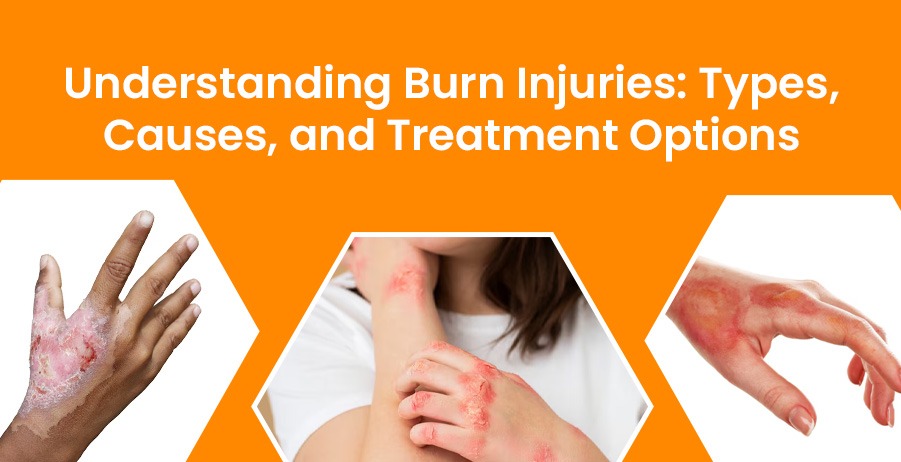
Life can change in a split second. One moment, you're cooking in the kitchen; the next, a splash of hot oil or a tipped-over pan of boiling water brings a searing, unforgettable pain. Almost everyone has experienced a minor burn, a brief, sharp reminder of how fragile our skin is. But when a burn is more severe, it’s not just a momentary injury, it's the beginning of a long journey, one that tests our physical and emotional strength.
Accidents can happen when we least expect them. Understanding what a burn injury really is, and knowing what to do in those first critical moments, is the first and most powerful step you can take on the path to healing.
More Than Just Heat: The Different Types of Burns
When we think of a burn, we usually think of fire or heat. But burns can also be caused by chemicals (like strong cleaning agents), electricity, or even excessive sun exposure. To provide the right care, doctors classify burns by their severity, or "degree":
- First-Degree Burns: The least severe burn, affecting only the epidermis (the outer layer of skin). A light sunburn may be experienced with some redness and pain along with minor swelling, but no blisters will present.
- Second-Degree Burns: More severe; damage extends through the epidermis and into the dermis (the underlying layer of skin). Second-degree burns are incredibly painful and will show exaggerated redness, along with swelling, and blisters.
- Third-Degree Burns: Third-degree burns are severe and result in the destruction of the top two layers of skin and changes may reach deeper tissues. This can range from white, leathery, and charred. The most frightening aspect of a third-degree burn is that it doesn't hurt as much, due to the destroyed nerve endings in the skin.
There are even deeper burns (fourth-degree) that can damage muscles and bones. Any burn larger than the palm of your hand, or any burn that you suspect is second-degree or higher, needs immediate medical attention.
The First Critical Minutes: First Aid for Burns
What you do in the first few minutes after a burn can make a huge difference in the healing process. Panic is natural, but try to remember these simple steps for first aid for burns :
- DO: Cool It Down. Immediately run cool (not cold or icy) water over the burn for at least 10-20 minutes. This will stop the burning process, and take away from your pain.
- DO: Remove Tight Items. Gently remove any rings, watches or tight clothing from the burned area - it will start to swell.
- DO: Cover the Burn. Use a clean cloth (or sterile dressing) that is lint-free and loosely covers the burn to protect it from getting infected.
- DON'T: Use Ice! Ice will only cause more harm to the fragile skin.
- DON'T: Apply Butter, Oil, or Ointments. These things will trap heat, causing more pain, and will only put you at a greater risk of infection. Use the cool water only.
- DON'T: Break Blisters. Blisters are your body's natural defence against infection. Let it be.
The Path Forward: Professional Burn Treatment
While first aid is a helpful first step, it is best to get professional medical help as soon as reasonable. The objective of medical management of burns focuses on two things: preventing infection and allowing for healing.
The physician will assess the level of injury and clean the wound. When they clean the wound, they may remove the burnt areas of skin. After the area is carefully cleaned, they will apply dressing (medical dressings are usually specialized and marketed to health care professionals). They will also apply topical medications for burn wounds (usually silver sulfadiazine cream or another type of topical antibiotic ointment) to keep the area clean and to fight off bacteria. You may receive a prescription of oral medications for pain control.
For more severe burns, the treatment is more intensive. It might involve:
- Skin Grafting: Where healthy skin is taken from another part of your body to cover the burned area.
- Physical Therapy: To keep joints flexible and prevent scars from tightening and limiting movement.
- Scar Management: Including treatments like laser therapy or pressure garments to help soften scars as they heal.
Healing is a Journey, Not a Destination
A severe burn is a life-changing event that leaves both physical and emotional scars. The path to recovery is a testament to human resilience. It’s a journey of a thousand small steps from the first moment of first aid to the final stages of scar maturation.
If you or a loved one is dealing with a burn injury , remember that you are not alone. With the right medical care and a strong support system, healing is not just a possibility; it's a promise. It's about looking forward, not with a reminder of the pain, but with the strength of a survivor.

